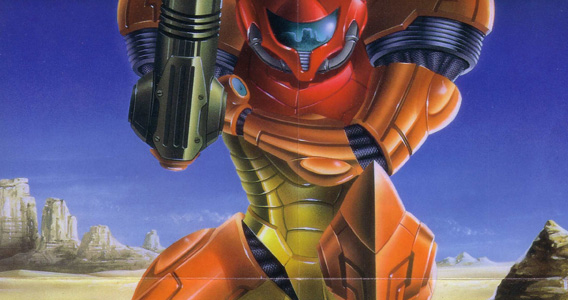
As a kid I never actually owned a Game Boy. I was one of the “turncoats” who went straight from the NES to the SEGA Genesis in Sonic the Hedgehog’s brilliant blue wake. That is not to say that I didn’t ever play any Game Boy games at the time. I had this good friend whose Game Boy was practically communal between him, myself, and his twin sister. We used to play Super Mario Land and Tetris almost constantly, draining a King’s ransom in batteries. I distinctly remember playing Metroid II shortly after it was released in Chris’s basement; making maps on foolscap, color coding different sections, the whole nine.
As a child I never did beat the original Metroid, nor did I complete its sequel, come to think of it. The Metroid games were something of mystery, an impossible enigma. There was an older kid in my neighborhood who had a code (his own personal password, you see) for the original NES game. He wouldn’t allow us into his parents basement until he had entered it, for fear of his password becoming common knowledge. We didn’t really care, though, because we just wanted to watch in awe while he decimated Motherbrain and gutted the white whale that was Metroid right in front of us.

The original Metroid for the Nintendo Entertainment System was among Nintendo’s earliest successes. Released very early in the life of Nintendo’s freshman console, Metroid struck a chord with gamers of the era. Boasting an enormous world, tons of upgradable weapons and armor, and an open ended freedom that is even today referred to as “Metroid-esque”, the game was key in exhibiting what could be achieved on home consoles. Add to that a highly effective minimalist soundtrack that perfectly complimented the bleak and lonesome atmosphere of the game itself, and Metroid was destined to be a masterpiece.
And then Nintendo surprised players by releasing the sequel for their newly portable Game Boy system.
Produced by famed Nintendo internal development team R&D1 and the father of the Game Boy itself, Gunpei Yokoi, Metroid II: The Return of Samus pushed the Game Boy’s capabilities to the limits in recreating sprites nearly identical to the 8-bit console predecessor.

The lack of background detail in the game, which was at the time (and even today) the biggest complaint levied against the game, are actually a key part of the game’s construct. Knowing it would be impossible to match the visuals of the original, Gunpei and team instead used minimalist design and high contrast to add a stark emotionless expression to the isolated planet SR388, where parallax scrolling and color were absent.
The story takes place after the original Metroid, and is currently 6th in the overall series continuity, chronologically existing just before the brilliant Super Metroid and after Metroid Prime 3: Corruption.
In Metroid II, Samus is sent by the Galactic Federation to destroy the Metroids at their source: SR388, their home planet. As Samus you execute the Metroid formula – blasting your way through the planet, collecting power-ups and upgrades, vying to reach the Mother Queen and incinerate it.
The Return of Samus is notable for the fact that it features the debut of the Varia suit, the costume most identified with Samus and the series as a whole. In fact, it is the duo-tone color palette of the Game Boy which is responsible for the Varia suit’s iconic round shoulders. These were added to differentiate it from the regular suit, since color was not available to make the difference obvious.

After destroying the Mother Queen and setting in motion the events that will destroy all Metroids and their entire natural ecosystem, a stray Metroid hatches and imprints onto Samus during her escape form the planet. Samus cannot bring herself to kill the orphaned Metroid, and the game ends with the two of them escaping the planet’s destruction together.
With a plot that is developed, and plays a key role in influencing events throughout the series, Metroid II stands head and shoulders above the majority of the Game Boy’s library and should be experienced by every series fan and action adventure game fan alike.
ahhh… the nostalgia…
Comment by Fingloi — February 6, 2013 @ 2:29 am